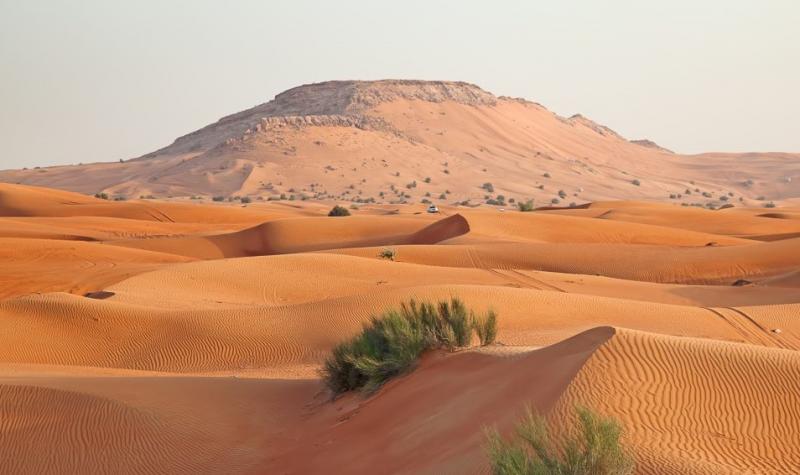
Wildlife in the Arabian Desert
Sprawling across the Arabian Peninsula, the imposing beauty of vast plateaus, rolling sand dunes, and towering mountain ranges of the Arabian Desert boast a mysterious allure. However, do not mistake the endless desert for being deserted—on the contrary, the Arabian Desert buzzes with life and activity. Often overlooked, this vast expanse of land stretching from Yemen to the Persian Gulf and Oman to Jordan promises a majestic experience with its own wonderful collection of wildlife and dramatic landscapes that rival the very best of African safaris. With an ecosystem uniquely adapted to the extreme conditions, witness some of nature’s most stunning creatures found only in the hidden corners of the Arabian Desert. From rare sand cat sightings in Oman and Nubian ibex duels in Jordan to Saudi Arabia’s circling Egyptian vultures, the Arabian Desert never fails to enthral its visitors.
Wildlife Experiences
-
Camel ride in Jordan
Arguably the best way to journey into the sand dunes, camel rides have been the mode of transport in these parts for centuries. Fondly known as the ships of the desert, camels’ specially designed hooves and unparalleled capacity to go weeks without water make them the perfect vehicle to guide you into the heart of the Arabian Desert. Mount this desert steed to wander into untold wonders of the vast desert and witness the magnificent biodiversity of the Arabian Peninsula.
-
Falconry in United Arab Emirates
In 2012, UNESCO added falconry to its Representative List of the Intangible Heritage of Humanity. As scholar Roger Upton describes, Arab falconry is not merely a sport or pastime, but a tradition reaching back centuries to pre-Islamic times and well worth protecting and observing. Still considered a rite of passage amongst youths, witness the magnificent training and flying of falcons and learn about the long history of falconry in Bedouin culture in one of the many reserves and falconry schools located directly in the Arabian Desert.
-
Birding in Oman
With dozens of endemic bird species adapted to both the Empty Quarter of the Arabian Desert and the multitude of blossoming oases, bird watching in Oman is an unforgettable experience. Witness the great spotted eagle, Egyptian vulture, the Arabian partridge, and Yemen serin in addition to a number of migratory birds from Europe, Africa, and Asia in birding trips that can be as short as an afternoon or as long as a few weeks.
-
Desert Night Safari in the United Arab Emirates
Encounter the wide array of desert wildlife on a unique night safari into the Arabian Desert. With the suffocating heat of the day, much of desert wildlife is nocturnal and only emerges at dusk for hunting and eating, making a night safari the perfect opportunity to see the wealth of the Arabian Desert. Hop into a jeep and slowly make your way into the depths of the desert to catch a glimpse of captivating desert nightlife.
8 animals
-
Arabian Oryx
After the last wild oryx was hunted in 1972, this magnificent antelope nearly disappeared altogether. Yet, thanks to animal sanctuaries and international re-introduction programmes, wild Arabian oryx made headlines as a conservation success story and are once again freely roaming the Arabian Desert. Oryx are mostly nomadic creatures, traversing the arid plains, wadis, and sand dunes of the desert to graze on grass and roots. With reflective white coats and an uncanny ability to smell water from miles away, oryx are well-suited to the extreme desert conditions.
-
Size: 100 to 210kg weight
-
Habitat: Sand dunes and stony desert plateaus in six distinct re-introduction locations throughout the Arabian Peninsula
-
Freaky fact: The Arabian oryx, with its long horns, is believed to be the origin of unicorn myths.
-
Sand Cat
Very little is known above this elusive nocturnal cat who expertly evades predation and human contact. With a camouflaged sandy brown coat and unusually large ears for detecting prey, this small hunter adapted well its desert home. During the day, sand cats will dig themselves burrows to hide from the hot sun and hunt at night, catching everything from rodents to snakes. Unfortunately, the presence of domestic animals and the destruction of the sand cat’s natural habitat threaten to endanger this desert felid.
-
Size: 1.4-3.4kg weight
-
Habitat: Sand dunes and arid plain of Saudi Arabia, Oman, Jordan, and the western Sahara
-
Freaky fact: Like domestic house cats, this wild desert cat purrs loudly but, like a dog, will bark to communicate with other sand cats.
-
Mountain Gazelle
With five distinct subspecies, the nomadic mountain gazelle migrates in herds across the steep terrain of the Arabian Peninsula. While some individual males will remain in the same territory all year, bachelor males and females will travel in separate herds in search of grass, shrubs, and herbs. However, the long legs, ringed horns, and chocolate brown ears of the mountain gazelle, once a common sight on the arid plains of the Arabian Desert, now face declining numbers.
-
Size: 16-29.5kg weight
-
Habitat: Rocky hills and mountains of Saudi Arabia, Yemen, Oman, and the United Arab Emirates
-
Freaky fact: The ringed horns of the male mountain gazelle can reach nearly 300mm.
-
Arabian Leopard
Perhaps the rarest leopard in the world, there are less than 200 surviving Arabian leopards in the wild of the Arabian Peninsula. Traditionally located in the high mountains and the deep wadis of the Dhofar region of Oman and across Yemen, the Arabian leopards are now threatened by frankincense collectors, habitat loss, and inbreeding. This large cat, with its trademark black spots and golden coat, may very soon be facing extinction if further conservation efforts are not made immediately.
-
Size: 20-30kg
-
Habitat: Hills and mountains of the Arabian Peninsula coastlands
-
Freaky fact: Arabian leopards do not open their eyes for 10 days after birth.
-
Nubian Ibex
A wild goat with curved horns, cloven hooves, and long beards, this relative of the antelope inhabits the rocky mountain regions of the Arabian Desert. Their ability to clamber over steep slopes and hills gives the ibex a distinct advantage when escaping predators, though the introduction of livestock into the region as well as widespread habitat loss has contributed to the population decline. While Nubian ibex are unable to communicate vocally, they boast a complex visual signal system.
-
Size: 65-75cm tall, 25 to 70kg weight
-
Habitat: Rocky desert hills and mountains in small areas of Saudi Arabia, Yemen, and Oman
-
Freaky fact: The long beards of the male nubian ibex leave a distinct scene that allow them to communicate with one another.
-
Hamadryas Baboon
Unlike many desert animals adapted to the little water of the desert, the hamadryas baboon is never far from a watering hole in the Arabian Desert. These omnivorous monkeys have long silver coats and striking pink faces and are known to eat grass, fruit, roots, and small mammals. Their complex social system is built upon distinct tiers: a group of female baboons are led by a single male who may come together with other female groups to form a much larger clan. At night, several clans may join together to form a band.
-
Size: 9.2-21.5kg weight
-
Habitat: Arid hillsides and mountains of western Yemen
-
Freaky fact: Ancient Egyptians considered the hamadryas baboon to be sacred.
-
Black Desert Cobra
The sleek, shiny scales of the black desert cobra are a truly fearsome sight to behold. This nocturnal cobra perfectly blends into the dark desert nights as it hunts toads in the depths of the stony desert and in the welcoming shores of the oases. Lately, black desert cobras have also been finding their way into local irrigation channels and agricultural olive groves. Be cautious if you come across one of these slithering predators, their venom is poisonous to humans!
-
Size:.5m
-
Habitat: Stony desert, vegetated gravelly terrain, and oases in western Saudi Arabia and parts of Jordan
-
Freaky fact: The longest black desert cobra ever recorded was 1280mm.
-
Golden Jackal
This skilled hunter is the most widespread species of jackals in the world. With its distinctive coarse golden coat and black tipped tail, the golden jackal is an extremely resourceful and opportunistic animal that can easily adapt to any environment. If you can an evening camel ride into the desert or embark on a night safari, it is likely that you will hear the barking, howling, or cackling of jackal packs off in the distance.
-
Size: 8-10 kg weight, 40-43cm tall
-
Habitat: Wide variety of habitats across Africa, the Middle East, southern Asia, and southern Europe
-
Freaky fact: After extensive DNA studies, the Golden Jackal was more aptly relabelled as a Golden Wolf two years ago but retains its original name.
4 birds side bar
-
Lanner Falcon
The lanner falcon boasts a dark brown feathered coat, soft white underbelly, and vibrant yellow feet to match its distinctive yellow beak and eyes. The lanner falcon often travels and hunts alone, eating smaller birds at waterholes.
-
Namaqua Dove
With a conspicuous grey coat and black feathered chest, the graceful namaqua dove is distinguished by its bright red and yellow bill. These migratory birds usually travel seasonally and with the rainfall, though some remain in permanent areas where food is abundant.
-
Pharoah Eagle Owl
The large bright yellow eyes of the pharaoh eagle do little to distract from its impressive wingspan and hooked beak. At night, you may catch a glimpse of its glowing eyes as it perches on a rock, hunting its prey.
-
Egyptian Vulture
With an intimidating pointed beak, yellow face, and uncanny red eyes, the sharp claws of the Egyptian vulture are ideal for this ruthless scavenger.
Share this article:




















